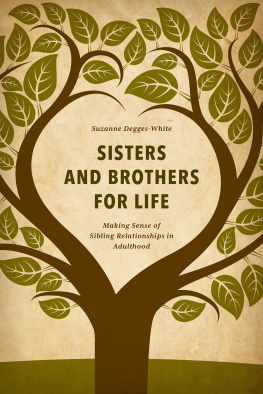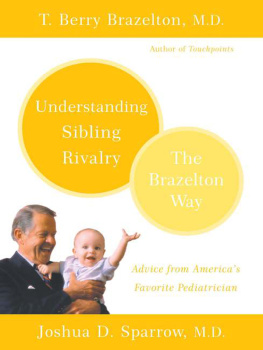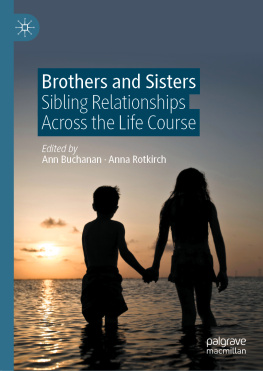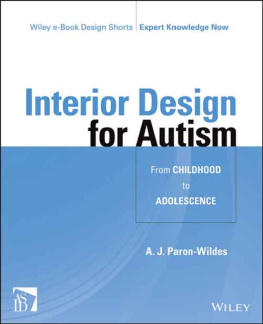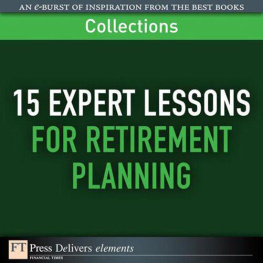Columbia University Press
Publishers Since 1893
New York Chichester, West Sussex
cup.columbia.edu
Copyright 2011 Columbia University Press
All rights reserved
E-ISBN 978-0-231-52793-4
Library of Congress Cataloging-in-Publication Data
Milevsky, Avidan.
Sibling relationships in childhood and adolescence : predictors and outcomes /
Avidan Milevsky.
p. cm.
Includes bibliographical references and index.
ISBN 978-0-231-15708-7 (cloth : alk. paper) ISBN 978-0-231-15709-4 (pbk. : alk. paper)
ISBN 978-0-231-52793-4 (ebook)
1. Brothers and sisters. 2. Sibling rivalry. 3. Birth order. 4. Parent and child. I. Title
BF723.S43M55 2011
155.99'24dc22 2010047314
A Columbia University Press E-book.
CUP would be pleased to hear about your reading experience with this e-book at .
References to Internet Web sites (URLs) were accurate at the time of writing. Neither the author nor Columbia University Press is responsible for URLs that may have expired or changed since the manuscript was prepared.
The inspiration for this book came from a bloody nose.
Many years ago, before becoming a psychology professor, I was a third-year doctoral student in the life-span development program at Florida International University struggling to find a suitable topic for my research focus. By the end of that year, with the decision-making process far from over, I was beginning to feel the pressure. Many of my colleagues were already applying for grants, conducting research, and publishing some of their findings on their way to establishing themselves as emerging experts in their fields. I needed to begin carving out my specialty area if I was to ever become an authority in some obscure subject matter of developmental psychology. Additionally, a very specific timeline was looming. Delaying the decision about my area of investigation would have initiated a cascading domino effect that ultimately would have resulted in having to delay my graduation, minimizing my chances of gaining a promising postdoc or professorship. Being told by countless professors that the topic chosen would probably become the main area of my research for the next decade or so, I was spending more time thinking about this decision than I did on the decision about whom to marry. After all, considering the rigorous tenure and promotion process in academia, I knew I would be spending more time with this topic than with my family once I became a professor.
During the same time, to supplement my modest income from a research assistantship, I was working weekends as a youth director at a local synagogue. My responsibilities included organizing and implementing social and educational programs for the children of the congregation during the Sabbath morning services. God forbid the children disturb their parents as they attempted to carry on a conversation about the real estate market during prayers.
One fateful Sabbath morning, as I was making the rounds from group to group checking that all the programs were running smoothly, I was approached by a frantic group leader who reported that two children in her 45-year-old group were fighting. Although by then I had spent quite a few years working with children, I was not prepared for what I witnessed when I entered the classroom. On the floor were two boys, Jake, a 4-year-old, and David, a 5-year-old, engaged in nothing less than an all-out brawl. In addition to the screaming, kicking, and scratching, one well-placed right hook from David made direct contact with Jakes nose. I was not sure if I heard a crack, but from the amount of blood that came out of this poor kids nose I suspected at a minimum a hairline fracture. However, most shocking of all was the identity of the two protagonists. Jake and David were siblings and none other than the rabbis two oldest sons.
I dont remember if that weeks biblical portion was Genesis, but they were doing a pretty good job reenacting the Cain and Abel story. My attempts at separating them were futile, and out of desperation I dashed downstairs toward the main sanctuary to summon the rabbiafter all, he was their father and should know what SWAT team was needed to intervene. As I approached the main sanctuary, much to my dismay, I noticed that the rabbi was in the middle of his sermon. My initial thought was to wait until he ended, but based on the fact that most of the congregants were still awake I knew that he must be in the early stages of the speech. The prohibition against disturbing the rabbi during the weekly sermon was the eleventh commandment, let alone the first clause of my contract, but I could not let the bloodshed continue. Against the advice of all my mental faculties I decided to enter the hall, proceed to the stage, and disturb the rabbis presentation.
I could only imagine what went through the congregants minds as I whispered into the rabbis ear, Your kids got into a violent fight upstairs, I need your help now. Begrudgingly, the rabbi excused himself as I followed him down the aisle, out the door, and up the stairs. Time did not heal this altercation. The fight was still in progress by the time we made it to the death-match room.
The naturenurture controversy relating to childhood aggression was put to rest that day. It was quite obvious where these children received their aggressive tendencies: that was one angry rabbi. The next few moments went by in slow motion. The father grabbed both of his children by the back of their shirts, pulled them off each other, and proceeded to drag them out into the hallway. He placed them down on the floor next to each other and began reprimanding them in a voice reserved for the clergy. As the rabbi continued his admonishment, I handed a bottle of water to Jake, the younger brother, so he could begin replenishing some of his lost blood.
What happened next was one of the most bewildering moments I witnessed in my years of working with children. As the father was continuing his tirade, Jake took a few sips from the water bottle, wiped the blood from his nose with his sleeve, and then in the most natural way proceeded to hand the bottle to his brother David, who took it and began drinking. They shared the water bottle! Mere seconds after the two brothers were on the verge of killing each other they shared the water bottle. At that moment I had the research topic that continues to fascinate me to this day: sibling relationships.
My journey into the fascinating world of siblings began ten years ago while I was a doctoral student of developmental psychology at Florida International University (FIU) in my adopted hometown of Miami. It was there that my mentor Dr. Mary Levitt introduced me to the crucial role played by members of an individuals social network throughout life. I would like to begin by expressing my gratitude to Dr. Levitt for directing me during those early years of my academic career. Even after I graduated and left her research group, she continued to advise me in many areas of academia. I am grateful for her constant support. Several other faculty members at FIU were instrumental in helping me clarify my research direction: Dr. William Kurtines, Dr. Marilyn Montgomery, and Dr. Patricia del Valle.






